|
Are There Alien Ruins In The Solar
System?
by
Steve
Johnson
For as long as mankind has
lived in communities, he has left remains behind for archaeologists to
discover. This might comprise of nothing more than an outline of a hut,
ash from a fireplace or pottery remains. The most spectacular remains are
the giant ruins left behind by the great builder civilisations of Egypt,
Mesopotamia and the Americas.
 The
pyramids of Egypt (left)are the most famous ancient ruins on Earth,
but there are many more ancient sites that tell the story of humanity
across the globe. Many of these were only discovered after painstaking
archaeological research, but others were in plain sight. The
pyramids of Egypt (left)are the most famous ancient ruins on Earth,
but there are many more ancient sites that tell the story of humanity
across the globe. Many of these were only discovered after painstaking
archaeological research, but others were in plain sight.
  From
above, complexes, such as Teotihuacán in Mexico and Angkor Wat in
Cambodia, stand out from the surrounding landscape, testaments to
humanity's ingenuity and technical prowess. But are they great feats of
engineering unique to our planet? Have we discovered ruins elsewhere on
the other planets of our solar system? From
above, complexes, such as Teotihuacán in Mexico and Angkor Wat in
Cambodia, stand out from the surrounding landscape, testaments to
humanity's ingenuity and technical prowess. But are they great feats of
engineering unique to our planet? Have we discovered ruins elsewhere on
the other planets of our solar system?
It seems an insane proposition, but
photographs returned from space probes offer tantalising glimpses that our
earthly relics may not be totally without precedent. Join me as I voyage
through our sun's family and explore some of the most intriguing images
ever captured by science.
The nearest body to Earth is the Moon
and it is here that we shall begin. This is the last place you would
expect to find ancient ruins. Everybody knows that the Moon has no
atmosphere and, as far as we know, it never has. How, then, can it contain
structures that seem to indicate the presence of a long-gone intelligence?
 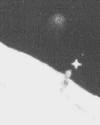 In
the mid-Sixties, the Lunar Orbiter probe snapped many images of our only
natural satellite. One in particular attracted the attention of anomalists
(those who seek anomalies). In one photograph, there appeared to be an
object sticking up from the lunar surface to a height of seven miles!
Dubbed The Shard or The Tower, it has become a subject of
great controversy. In
the mid-Sixties, the Lunar Orbiter probe snapped many images of our only
natural satellite. One in particular attracted the attention of anomalists
(those who seek anomalies). In one photograph, there appeared to be an
object sticking up from the lunar surface to a height of seven miles!
Dubbed The Shard or The Tower, it has become a subject of
great controversy.
It is a genuine feature, of that there
is no doubt, you can see its shadow casting to the right, but is it an
artificial structure? There are other explanations, of course. It may be
some sort of outgassing from the Moon (although if it were, it would be a
unique phenomenon) or could it be a plume of dust from a meteorite impact?
 Another
unusual feature on the Moon is known as the Blair Cuspids. These
intriguing structures are located on the western edge of the Sea of
Tranquillity and are 'officially' explained as boulders that cast long
shadows because of the terrain and the low angle of the sun. Independent
researchers, though, claim that the official explanation does not answer
all of the 'problems' with the Cuspids and that they actually are tall,
spire- or tower-like structures on the Moon. Another
unusual feature on the Moon is known as the Blair Cuspids. These
intriguing structures are located on the western edge of the Sea of
Tranquillity and are 'officially' explained as boulders that cast long
shadows because of the terrain and the low angle of the sun. Independent
researchers, though, claim that the official explanation does not answer
all of the 'problems' with the Cuspids and that they actually are tall,
spire- or tower-like structures on the Moon.
If The Shard and The Blair Cuspids are
artificial structures, who built them and why? There are other features
that anomalists have claimed depict artificial constructions, such as
glass domes, geoglyphs, a suspended castle-like structure and even a huge
bridge, but the photographic evidence for these is open to much
interpretation, in my opinion. The features I have focussed on are there,
clear and tangible, for all to see.
Our next stop is the planet Mars, a
world long thought to contain life. Wells' invaders hailed from the Red
Planet and the respected astronomer Percival Lowell had claimed that he
had glimpsed canals criss-crossing its russet surface.
When the Mariner probes arrived in
orbit of Mars in the mid-Sixties, hopes of finding complex life were
dashed. A cratered, lunar-like landscape disappointed many, but the story
hadn't ended when it appeared that Mars was a dead world.
 Some
of the Mariner images seemed to show what looked like pyramids on Mars.
Even the late, great Carl Sagan referred to them as pyramids and compared
them with those of Sumer and Egypt. Not only that, the probes also found
evidence that great rivers had once flowed across the surface. Perhaps
Lowell had not been so wrong after all! Some
of the Mariner images seemed to show what looked like pyramids on Mars.
Even the late, great Carl Sagan referred to them as pyramids and compared
them with those of Sumer and Egypt. Not only that, the probes also found
evidence that great rivers had once flowed across the surface. Perhaps
Lowell had not been so wrong after all!
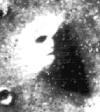 Perhaps
the most famous anomalous feature on Mars is the Cydonia Face. This
enigmatic structure was first found on low resolution images taken by the
Viking orbiters in the 1970s. It captured the imagination of the general
public and seemed to many to conclusively prove that there had once been
intelligent life on Mars. Facial symmetry was noted, even though half of
the face was cast in darkness, and some enthusiasts even claimed to be
able to make out an eyeball, nostrils and even teeth in the mouth. Perhaps
the most famous anomalous feature on Mars is the Cydonia Face. This
enigmatic structure was first found on low resolution images taken by the
Viking orbiters in the 1970s. It captured the imagination of the general
public and seemed to many to conclusively prove that there had once been
intelligent life on Mars. Facial symmetry was noted, even though half of
the face was cast in darkness, and some enthusiasts even claimed to be
able to make out an eyeball, nostrils and even teeth in the mouth.
When the Mars Global Surveyor probe
parked itself in orbit in 1997, the anomalist community held its breath.
Would the higher resolution cameras on MGS prove that the Face was a huge
sculpture, or just a normal hill, a mesa with human-like features caused
by tricks of light and shadow, as the experts claimed.
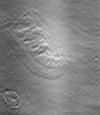 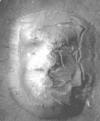 The
first image emerged in 1998 and caused howls of derision from face
enthusiasts. Dubbed 'the catbox', because of its similarity to a cat's
litter tray contents, the image was possibly the worst that could have
been released to a hungry public. The
first image emerged in 1998 and caused howls of derision from face
enthusiasts. Dubbed 'the catbox', because of its similarity to a cat's
litter tray contents, the image was possibly the worst that could have
been released to a hungry public.
We had to wait three more years for a
better, high resolution image. This one split opinions right down the
middle. Many claimed that this new picture proved that The Face was
nothing more than a mesa, bearing no resemblance to a humanoid visage,
while others said that it still showed features present in the old Viking
photos i.e. an eyeball, a nostril and teeth in the mouth. The previously
dark right side of the feature could now be seen and even this divided
opinions, with some saying that the symmetry still worked.
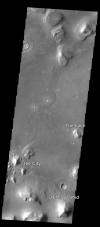 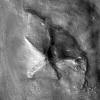 The
latest image from Cydonia, taken by the THEMIS camera aboard the orbiting
Mars Odyssey probe, shows The Face in context with nearby structures. Here
we can see The Face, the five-sided D&M pyramid (named after its two
discoverers, Vince DiPietro and Greg Molenaar) and the area known as The
City, where researchers claim they have found geometry that could not have
happened by the chance of nature. The
latest image from Cydonia, taken by the THEMIS camera aboard the orbiting
Mars Odyssey probe, shows The Face in context with nearby structures. Here
we can see The Face, the five-sided D&M pyramid (named after its two
discoverers, Vince DiPietro and Greg Molenaar) and the area known as The
City, where researchers claim they have found geometry that could not have
happened by the chance of nature.
Mars is replete with anomalies and it
seems that every new image throws up something new for everybody to
scratch their heads at. Below are a few for you to ponder about:
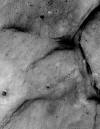
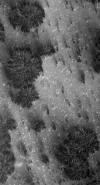

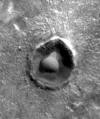
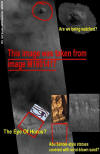
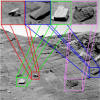

Even the moons of Jupiter have been
scrutinised by anomalists, with icy Europa drawing most attention. This
body is one of the best candidates for life in the solar system. beneath a
thick, ice crust, it is believed that a deep ocean exists and life may
dwell in those murky depths. It's the fractured surface, though, that has
attracted attention. Some have claimed that geometric shapes can be seen
in the cracks, shapes that cannot occur in nature.
Beyond Jupiter lies Saturn and its
splendid system of rings. This gas giant has more moons than any other
planet in the solar system and its family are amongst the most intriguing
and mystifying.
Titan is the only moon in the solar
system with a dense atmosphere. A recent landing by the Huygens probe
found a freezing, snowy surface, but no oceans of hydro-carbons, as
posited by some, optimistic boffins.

Mimas looks like the Death Star from
the Star Wars movies, with its huge impact crater, Herschel.

Enceladus appears
to clean its landscape every so often, suggesting that an internal heat
source causes liquid to erupt through its icy surface.
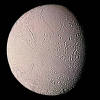
 Of
all the Saturnian moons, though it is Iapetus that has caused the most
intrigue. Its discoverer, Giovanni Cassini, deduced way back in the
seventeenth century that one side of this moon was darker than the other,
as he could only see it on one side of Saturn (tidal locking causes most
moons to keep one face towards their parent planet at all times). When the
Voyager 2 probe passed Iapetus in 1981, it confirmed Cassini's
observations. In fact, the dichotomy between the two hemispheres was so
marked that it became known as the Yin-Yang Moon! Of
all the Saturnian moons, though it is Iapetus that has caused the most
intrigue. Its discoverer, Giovanni Cassini, deduced way back in the
seventeenth century that one side of this moon was darker than the other,
as he could only see it on one side of Saturn (tidal locking causes most
moons to keep one face towards their parent planet at all times). When the
Voyager 2 probe passed Iapetus in 1981, it confirmed Cassini's
observations. In fact, the dichotomy between the two hemispheres was so
marked that it became known as the Yin-Yang Moon!
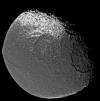 When
the space probe named after the moon's discoverer began its mission at
Saturn, we got the best ever look yet at Iapetus and the mystery only
deepened. When
the space probe named after the moon's discoverer began its mission at
Saturn, we got the best ever look yet at Iapetus and the mystery only
deepened.
What the new
images showed stunned scientists and explanations are still being sought
today. Towering twelve miles above the surface, a huge ridge spans the
entire dark hemisphere of Iapetus. It follows the equator perfectly and
maintains a regular width along its length.
While scientists
attempt to explain it as an unusual, yet natural, feature, some
researchers are suggesting that Iapetus may in fact be an artificial
structure in itself, perhaps a massive, ancient space station from a
long-lost civilisation. Indeed the images from Cassini do seem to show
that Iapetus is less spherical and more polyhedral in shape, with its
horizon appearing to consist of straight edges rather than graceful
curves.
If Iapetus does
turn out to be an artificial construct, it would be the greatest discovery
of all time, but I suspect a natural explanation will be found.
We have taken a
tantalising glimpse through some of the anomalies within our solar system,
but we are left with more questions than answers. If these are
ancient ruins, who built them? Was there an ancient Martian civilisation
that built pyramids? If so, what does this mean for us on Earth? Did these
Martians realise that their planet was doomed and relocate to a nearby
planet that could sustain them? A blue-green planet that we call Earth?
Did they send out explorers to the far reaches of the solar system,
building colonies as they went? Is Earth the last remaining colony? Are we
the descendants of Martian refugees?
Or was there an
advanced civilisation from Earth that travelled into space, building these
structures as it went, only to die out or slip back due to some great
cataclysm?
Or are the ruins,
if that is what they are, remnants of completely alien origin from beyond
our solar neighbourhood?
Or is it all
wishful thinking?
© 2005 Steven
Johnson |